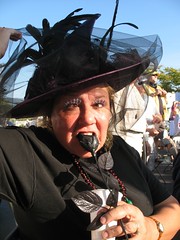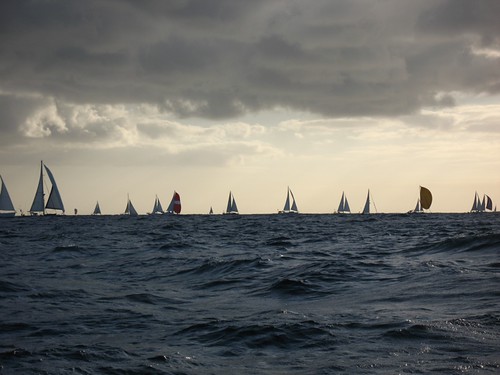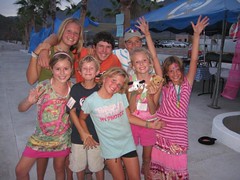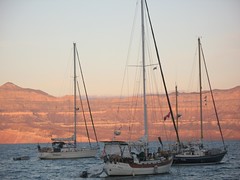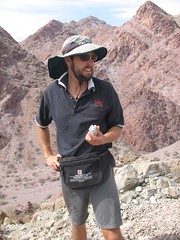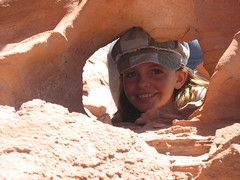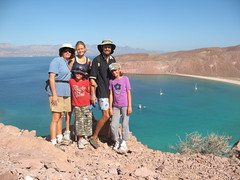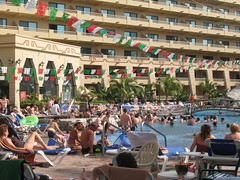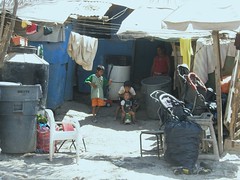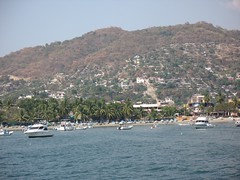The Baja Ha Ha is a rally of cruising boats -- mostly sail -- that leave San Diego at the end of October for a ten day run down the coast of Baja California to Cabo San Lucas. It's part party, part support group, part race, part rally, part event. It is a way to meet the other boats with whom you are likely to cruise the winter months on coastal Mexico or jump across the Pacific in spring.
There are purists sailors who poo poo the ha ha. "Too many boats with too few real sailors." "Just a party." "Dangerous with all those newbies." "Who wants to sail with a crowd like that." DrC and I, however, are strong proponents of the Ha Ha with nothing but good to say. Sure, you have to be careful as a lot of the boats lack experience -- best to always anchor upwind of the Ha Ha fleet and run at least 60 miles off shore to avoid the madding crowd. Yet, we met many of our favorite people during Ha-Ha 2008. Victory Cat, Sea Level, Third Day, Bay Wolf... these are all people whose lives made our own so much better and so much richer. And naysayers be damned, our girls absolutely adore Richard (the Grand Pooh Bah) and his lovely wife, and one of our happiest memories was a day the girls spent cruising at 18 knots on Profiligate during the Sea of Cortez Sailing Week then coming into the harbor dancing on the bimini cover to the blasting notes of "Walk Like an Egyptian." Had we not Ha-Ha'd, we wouldn't have had that opportunity... we might have known that such an opportunity even existed.
But I do have a few recommendations for prospective Ha-Ha'ers or, in fact, any boat migrating south to Mexico this winter.
Do NOT pack large amounts of rice, beans, and canned goods. Mexicans eat well, and food prices are on the whole considerably cheaper. The produce is often outstanding, and meat and poultry are healthier albeit considerably leaner.
DO fill the lockers with your favorite sauces, spices, and exotica. Mexican supermercados are well stocked, but you often can't find specific brands or particular condiments you love. This is true of New Zealand as well... probably of any country. Your favorite curry mix or salad dressing may only be available in your homeland.
Do NOT buy out the West Marine across from the Ha Ha kick off party, getting every possible part, nautical trinket, boat jewelry, or electronic gadget.
DO buy out the West Marine across from the Ha Ha kick off party. What the hell. It's the last time you'll see any of this stuff, your last time to indulge in American-style consumerism. From now on, it'll take a trip to fifeteen separate ferrerterias to accomplish anything. Actually, buy out the Home Depot while you are at it.
Do NOT get a new dodger, steel frame for your solar panels, dinghy cover or any other canvass work. All this can be done cheaper and better in Mexico.
DO buy Sunbrella if you plan to have said covers made. The stuff costs twice as much in Mexico and that is assuming you can find it.
Do NOT pack fancy clothes, cutlery, or makeup. You will not actually go out to a fancy dinner. Anywhere. For years.
DO pick up some wine glasses (if available) embossed with the Ha Ha logo. We have reason to be thankful for these (Ha-Ha Solves Robbery in Auckland).
Do NOT spend oodles purchasing every chart and cruising guide you can find on Mexico. Charts south of the border are notoriously inaccurate and essentially a profound waste of space and money.
DO buy whatever electronic chip you need for your nav system and the oldest copy of Yachtsman's you can find on eBay, Craigslist or your used nautical shop. Also, you must buy a copy of Sea of Cortez -- and if it's for sale this season -- get Blue Latitude's sequel on Pacific Mexico. Shawn and Heather's book(s) are more accurate than Mexican charts and a complete replacement of Charlie's and Raines. Even their draft of Pacific Mexico was a better aid to navigation when we were down in Bahia Banderas than our "legal" charts.
Do NOT take the Ha Ha lightly. It is not a downwind pleasure cruise comparable to taking a day sail in San Francisco Bay. Just look at the stories from last year -- even though you are leaving in late October, the weather can be awful and disaster can and will strike even highly prepared boats.
DO be prepared. I love the West Coast of the United States as a way of easing into the cruising life. First, you can learn the intracies of intercoastal travel and anchoring. Then you can dip your toe in short hop ocean cruising. The trip from San Diego to Cabo is your next big welcome-to-the-next-level moment where the smart bet is to take the boat completely off shore. You'll be doing round the clock watches for two to four days, sailing at night, and playing footsie with commercial, cruise boats out on the rhumb line. Head Latitude 38's warning that the Ha Ha is not a trip for beginner sailors -- beginner cruisers maybe but not beginner sailors. It is definitely not a trip for unprepared boats.
Do NOT overload your boat with stuff. Mexico is not a third country. It is a wonderful place with plenty of shopping opportunities. You can find pretty much anything you need -- clothes, household goods, food stuffs, tools, and most parts -- in the big cities.
DO contact Club Cruceros and see if anyone needs something brought south. It will usually be small and either hard to find boat parts or gifts from family. In fact, if you're willing to pick up a wind generator for me in San Diego...
Do NOT be afraid. You are considerably more likely to get hit by lightening than you are to be attacked by Mexican drug runners during your trip south.
DO leave American news-media induced fear, uncertainty and dread (FUD) behind. You are stepping into a whole new world now, and I don't mean Mexico. You are launching your career as a cruising sailor. This new life will be slower, quieter, and full of small wonderous moments. YOu may work harder physically than you have since high school sports, but the work is rewarding, satisyfing in ways that our daily works lives often are not.
And do look out for Don Quixote as you pass through La Paz. She's hard to miss as she's on an inner dock, right in front of the restaurant. She's dirty, lonely, and neglected. We've treated her badly. Give her a pat for me, and let her know we're coming home. We miss you all so much, cruising family. See you in February.

